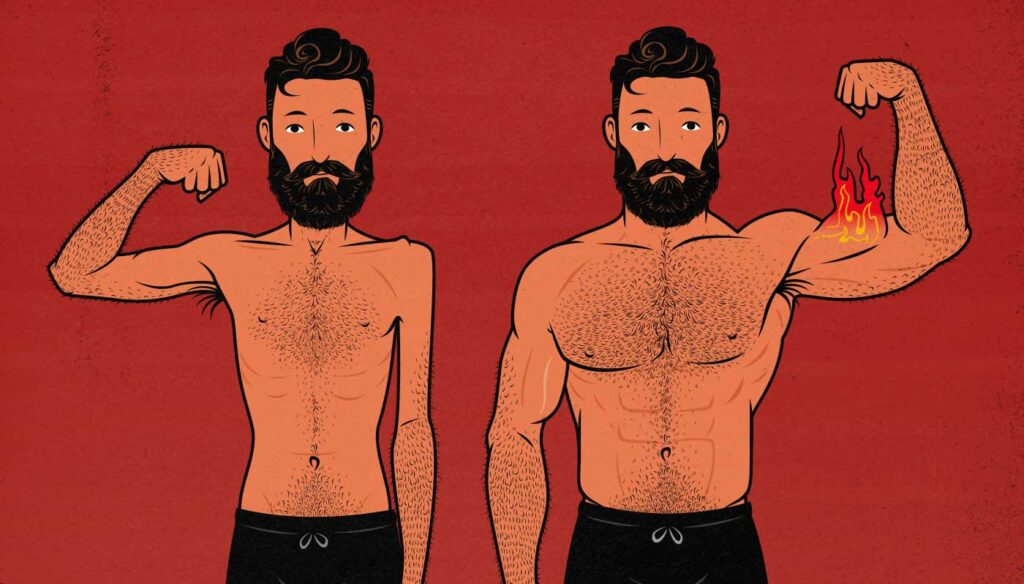
How to Gain Less Fat While Bulking
One of the most common problems people have is that they bulk up, gain a bunch of fat, and finish looking out of shape instead of looking more muscular. They might have gained a fair amount of muscle mass and strength, but their progress is hidden by their rising body-fat percentage.
Most of us work out to build muscle, get stronger, improve our health, and improve our appearance. Bulking will certainly make us bigger and stronger, but if it comes at the cost of our health and appearance, is it really worth it?
Despite the protestations of your inner nihilist, yes, gaining both muscle and fat is probably still worth it. You can burn the fat while keeping the muscle and strength, becoming both leaner and more muscular by the end of it. It just means having to go through a period of fat loss. That’s a pain, but it’s still progress.
But wouldn’t it be nice to gain less fat while bulking? You’d finish your bulk looking great. You could spend longer building muscle before needing to trim off the fat. And you wouldn’t need to spend months cutting afterwards.
So in this article, we’ll talk about why some people gain a disproportionate amount of fat while bulking, and then go over a few strategies to increase your muscle growth and reduce your fat gain, allowing you to build more muscle leanly.
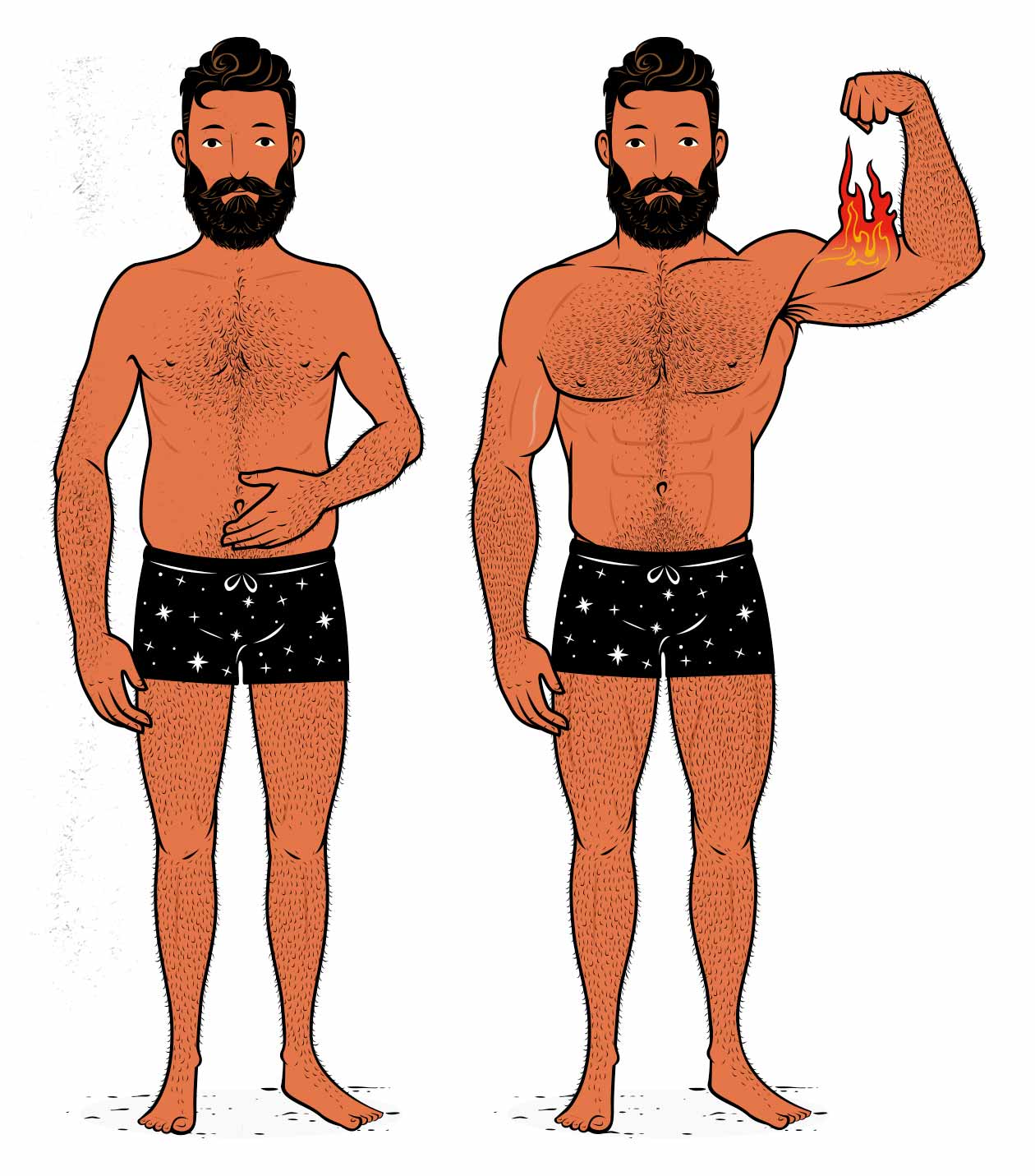
Why Do People Gain Fat While Bulking?
To bulk, you need to eat in a calorie surplus. It’s that calorie surplus that causes you to gain weight, and it’s that weight gain that maximizes your rate of muscle growth. The reason you gain fat while bulking is because some of the surplus calories you’re eating are being stored as body fat instead of being invested into muscle growth.
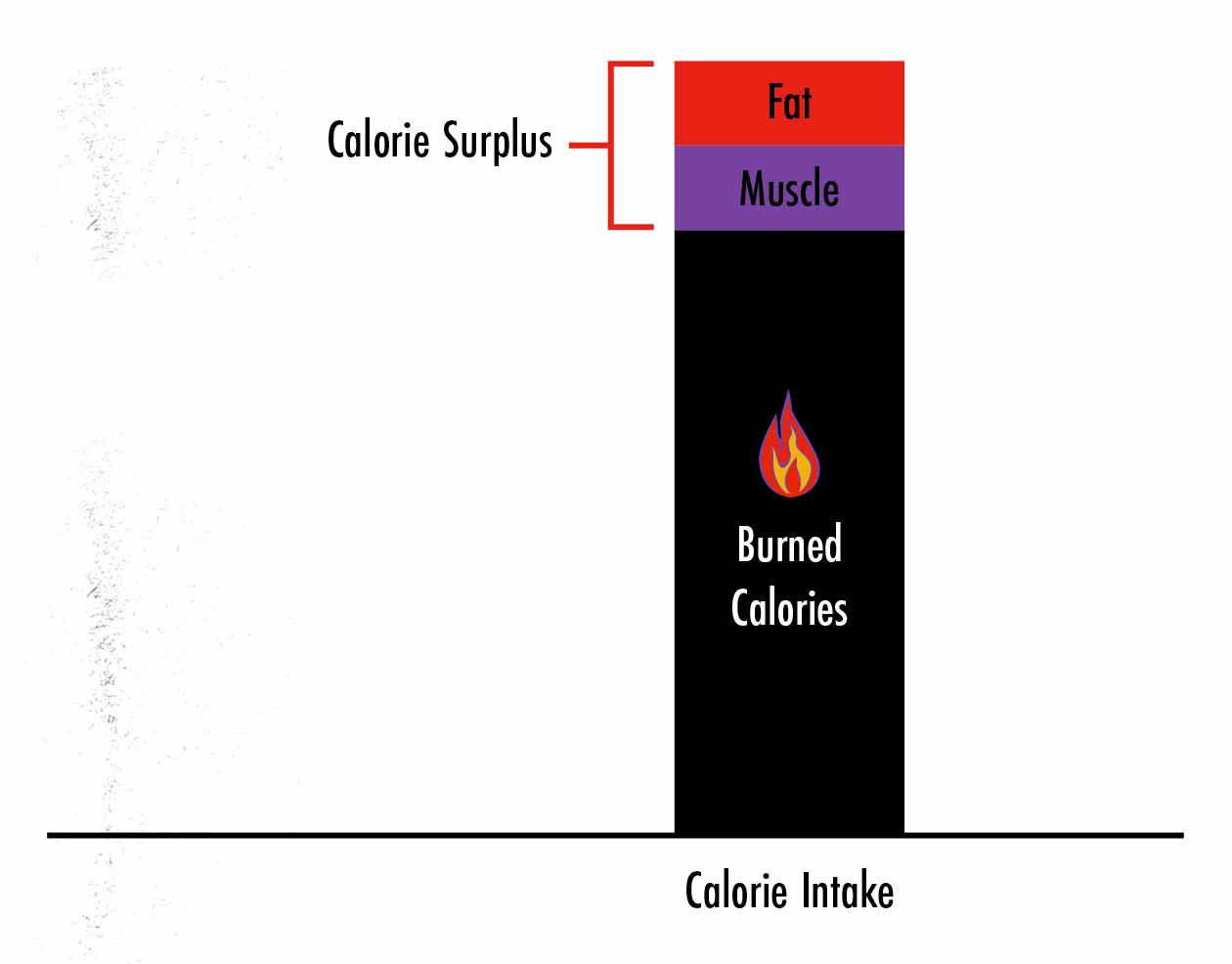
Gaining Weight Too Fast
The main reason that people gain a disproportionate amount of fat while bulking is because they’re eating too many calories and gaining weight too fast. This is where a lot of bulks go wrong. There’s a limit to how quickly you can gain muscle, and so if you’re gaining too much fat, you should reduce your calorie surplus, like so:
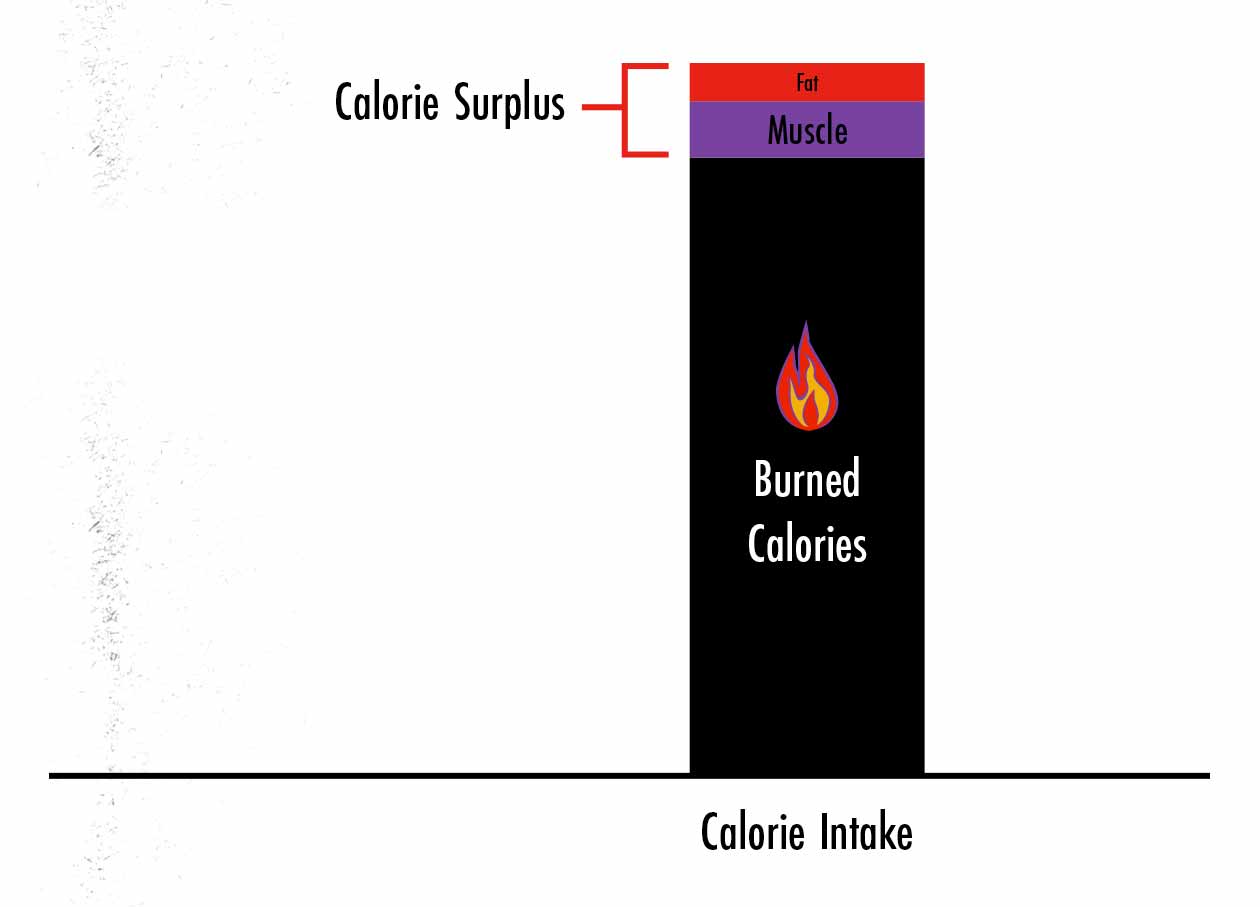
What we’re seeing here is that by reducing our calorie intake, we’re gaining slightly less muscle, but we’re radically reducing how much fat we’re gaining. For example, here are the results of a recent study:
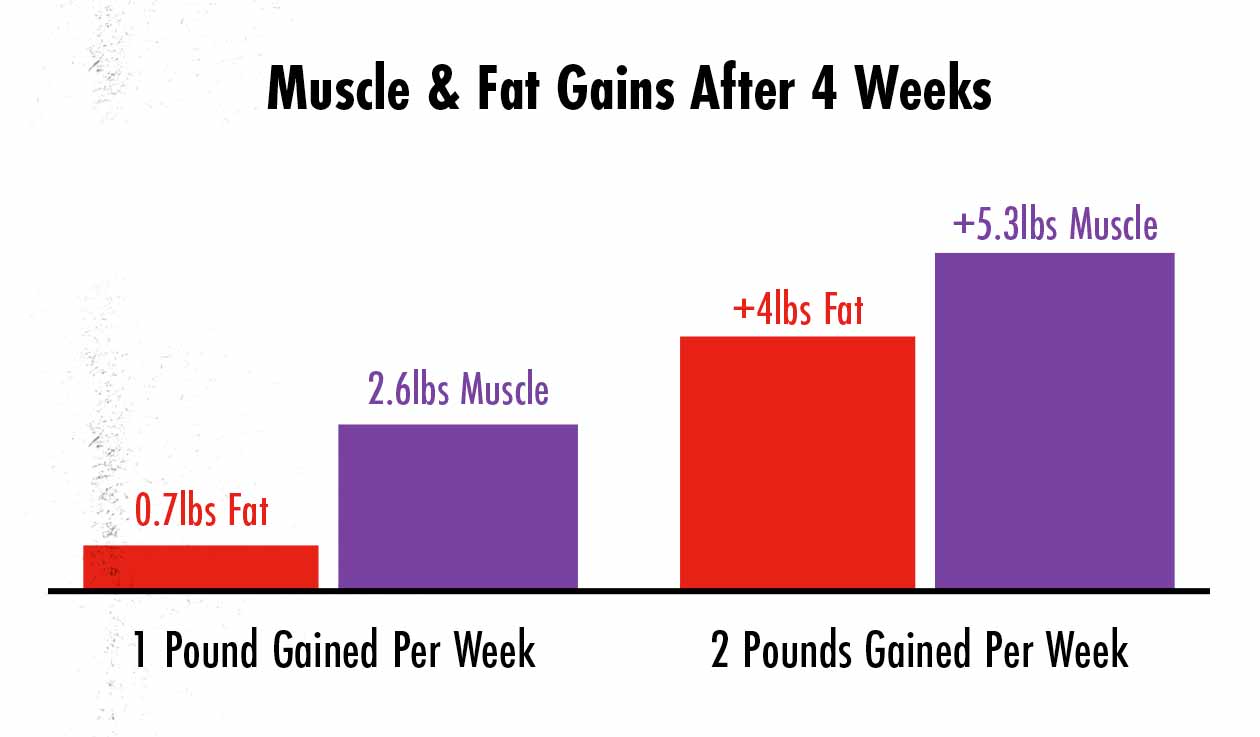
By gaining one pound per week instead of two, the participants cut their rate of muscle growth in half, but only gained a fifth as much fat. So even though their rate of muscle growth is only half as good, their ratio of muscle-to-fat gain is twice as good. Is that a good thing? It depends on your goals. But if you’re gaining too much fat while bulking, this is one of the best ways to rein your fat gain in.
Not Gaining Enough Muscle
The other reason that people gain too much fat while bulking is because they aren’t stimulating enough muscle growth. The less muscle growth we stimulate, the fewer calories will be invested into muscle growth, and the more calories will be left to store as body fat. What’s great about this point, though, is that by building muscle faster, we can also gain it more leanly.

This is the very heart of bulking. The whole reason we’re in a calorie surplus in the first place is to increase our rate of muscle growth. So if we can adjust our workout routines, diets, and lifestyles to gain muscle even faster, then our bulks becomes better in every way.
So to summarize, to keep our gains lean while bulking, we need to stimulate as much muscle growth as we can, and then we need to make sure that we aren’t gaining weight too fast. Let’s talk about how to do that.
The Five Principles of Lean Bulking
Lift for Muscle Growth
The best thing we can do to improve our bulking results is to stimulate more muscle growth, and by far the most powerful tool we have at our disposal is our training. We’ll talk about protein, sleep, macros, and calorie surpluses, but all of those factors pale in comparison to the muscle growth that we can stimulate with our training.
There are different ways of exercising, ranging from running to resistance training. Most people know that resistance training is better for building muscle, but there are several different types of resistance training, too. You can train to become stronger for your size (strength training), to develop more explosive power (Olympic weightlifting) or to build more muscle mass (hypertrophy training). And even within hypertrophy training, we can use several different tools, ranging from resistance bands to exercise machines to free weights.
So, ideally we want to train for pure muscle growth: hypertrophy training. We’ll gain some strength and power, and we’ll improve our general fitness, but those are just byproducts. When we’re bulking, the main thing we should be training for is muscle size. And then afterwards, if you want to become stronger for your size, that’s when something like strength training would come in. But when you switch to strength training, you’d want to rein your calorie surplus in so that you aren’t gaining a bunch of extra body fat.
Here’s how to train for muscle growth:
- Choose good exercises: we want to build our routines on a foundation of compound lifts, such as the front squat, bench press, deadlift, overhead press, and chin-up. After that, we can add in smaller lifts to work the muscles that aren’t being fully stimulated, such as our biceps, triceps, side delts, necks, and so on. But those are icing on the cake.
- Do enough sets per week: most research shows that doing somewhere between 9–18 sets per muscle per week is ideal for building muscle.
- Do enough reps per set: anywhere from 4–40 repetitions per set will build muscle, but we tend to gain more muscle more easily when lifting in the 6–20 rep range. Usually, the big compound lifts are done for lower reps and the lighter isolation lifts for higher reps.
- Rest long enough between sets: we usually need to rest somewhere between 2–5 minutes between sets, allowing us to lift harder in subsequent sets, stimulating more muscle growth.
- Train often enough: to maximize our rate of muscle growth, we want to train our muscles 2–4 times per week, and 4-day workout splits are perfect for this.
- Train hard enough: to make sure that we’re challenging our muscles, we need to bring our sets within 0–3 reps of failure on most sets.
- Outlift yourself: we don’t need to hit PRs every workout, but we should always try to either add weight to the bar or eke out extra reps. That’s how we achieve progressive overload, becoming bigger and stronger over time.
There’s no single workout routine that’s best for all of this, but as a rule of thumb, newer lifters tend to do well with 3 full-body workouts per week, whereas stronger intermediate lifters often benefit from training 4 days per week.
Eat Enough Protein
Once you’ve optimized your lifting routine for muscle growth—including finding a good workout program, following it consistently, and making sure that you’re pushing yourself hard enough—the next thing to consider is your protein intake.
Most lifters know that they should be eating at least 0.8 grams of protein per pound bodyweight per day. For example, at 170 pounds, that means eating at least 136 grams of protein per day. And that’s fairly simple in theory. Still, some people mess it up. It can take some effort to bring your protein intake that high.
Plus, it helps if you spread that protein out over several meals, including at least 20 grams of protein in breakfast, lunch, dinner, and maybe a snack or two. Here are some examples of balanced bulking meals.
So, if you’re having trouble gaining muscle leanly, consider tracking your protein intake for a couple of weeks to make sure that you’re consistently getting enough protein per meal and per day.
Get Enough Good Sleep
Once you’re training for muscle growth and eating enough protein, the next thing to look at is your sleep. A recent study found that when lifters were taught how to improve their sleep, they gained muscle 30% faster than the control group:
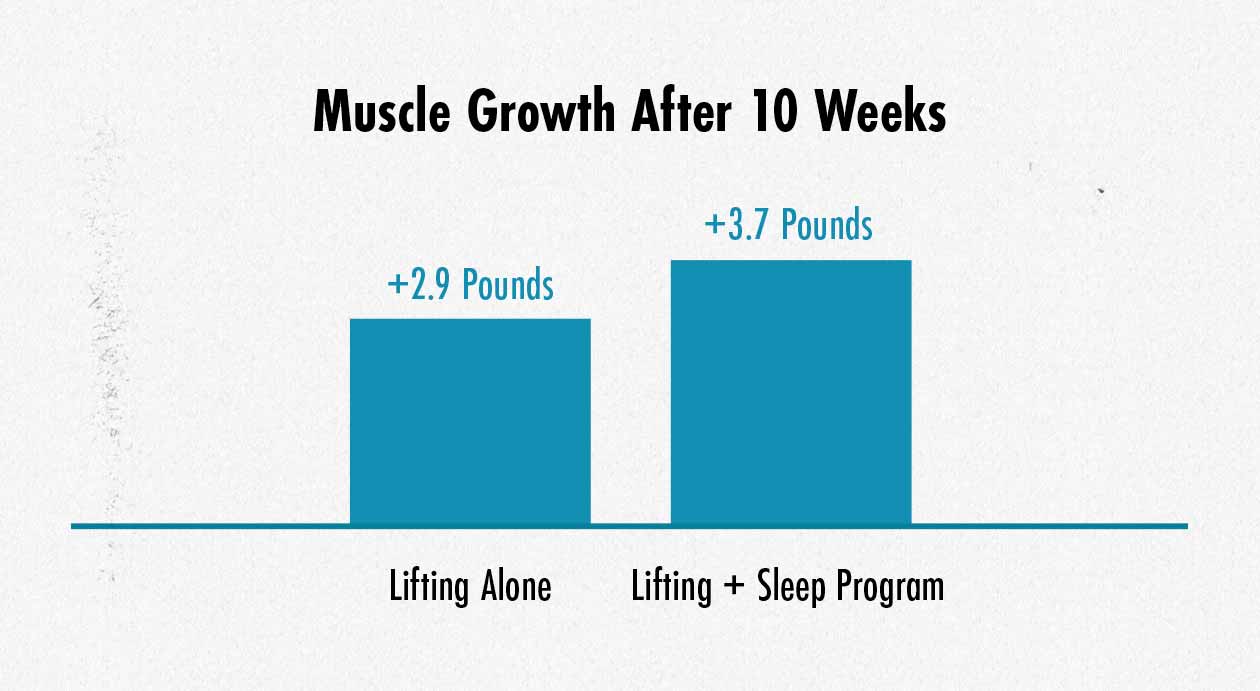
What’s even more impressive is that the group who was getting better sleep not only build muscle faster, but they also did it while eating fewer calories. Normally that’s hard to do, but in this case, they achieved simultaneous fat loss and muscle growth:
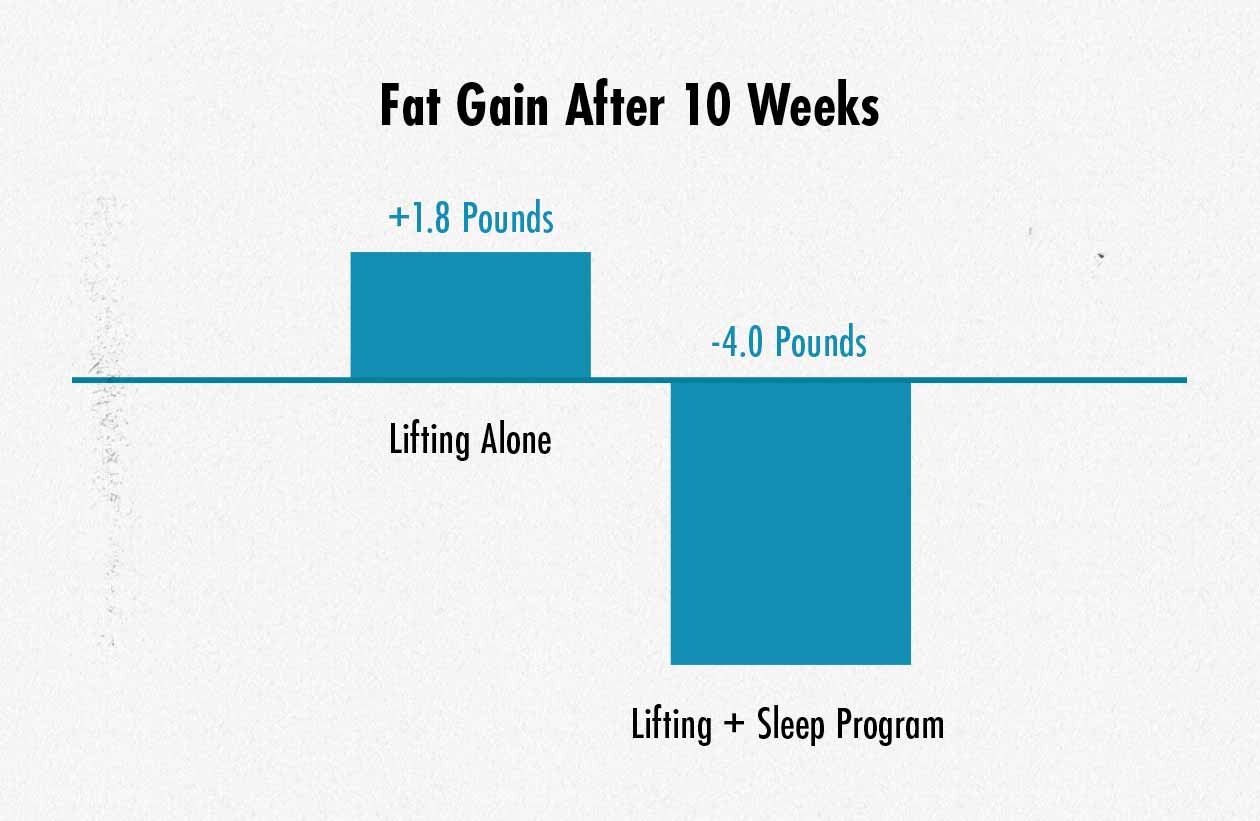
This study isn’t an outlier, either. Previous research found the same effect. By improving our sleep, we can reliably build more muscle and gain less fat while bulking.
There are two aspects of sleep that we want to look at: quantity and quality.
- Get enough sleep: 7–8 hours is enough for most people. I recommend giving yourself 8–8.5 hours and then seeing if you wake up early. Then, if you find that you’re routinely waking up after 7 hours feeling refreshed, great. Switch to 7 hours.
- Get better quality sleep: the next thing is trying to get deep, restful sleep without waking up more than once per night. Dimming the lights in the evening and doing something relaxing in the hour leading up to your bedtime can help a great deal.
We can go much deeper, though, and each of these points has some nuance. If you want more, check out our article on improving sleep for lean muscle growth.
Live a Healthy Lifestyle
The next thing to consider is that you aren’t living an unbalanced or unhealthy lifestyle. So think about things like:
- Are most of your calories coming from whole foods?
- Are you limiting yourself to 0–2 piña coladas per day?
- Do you spend some time being active, such as doing some cardio, playing sports, or going on daily walks?
- Are you regularly getting outside and getting some sun? And if not, have you checked your vitamin D levels?
- Are you managing your overall stress levels?
None of those things are major factors for gaining fat on their own, but when you add them up, they may have a noticeable effect. And if you combine them with a good workout routine, enough protein, and enough good sleep, you’ll be in a great position to gain muscle leanly.
For more, we have a full article on how to bulk the healthy way.
Don’t Gain Weight Too Fast
Now that we’ve got the basics of bulking down—hypertrophy training, eating enough protein, getting enough sleep, and living a healthy lifestyle—we can talk about how quickly you want to gain weight. If you’re a skinny beginner, you might be able to benefit from bulking more aggressively. For example, here’s GK gaining about 1.5 pounds per week for 20 weeks:
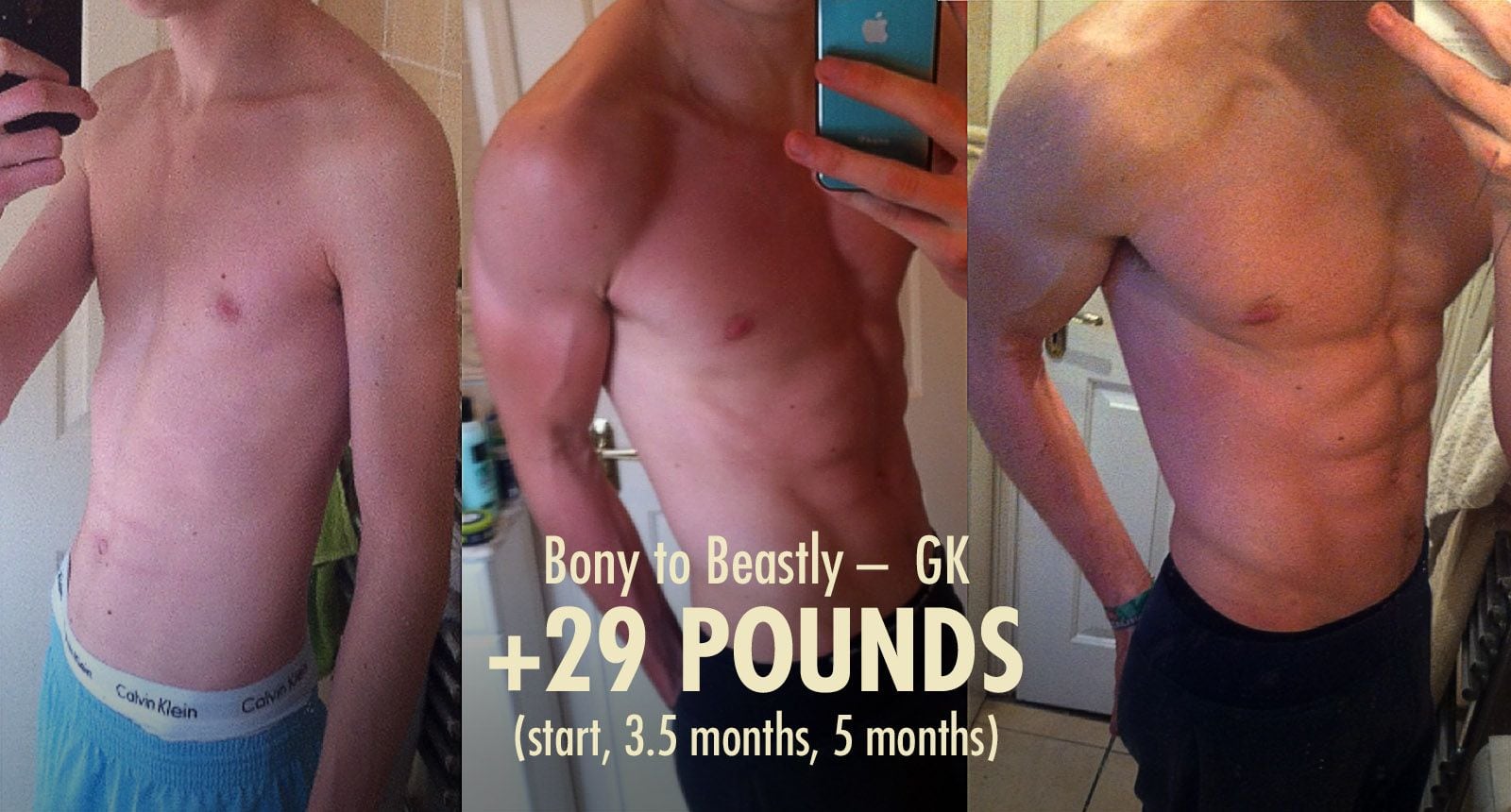
But once you’ve gotten your newbie gains, most research shows that gaining around 0.5–1 pound per week is ideal. For example, this systematic review by Eric Helms, PhD, recommends a calorie surplus of 350–500 calories per day, which is around 0.7–1 pound gained per week. For example, here’s Johnny gaining around 1 pound per week for 20 weeks:
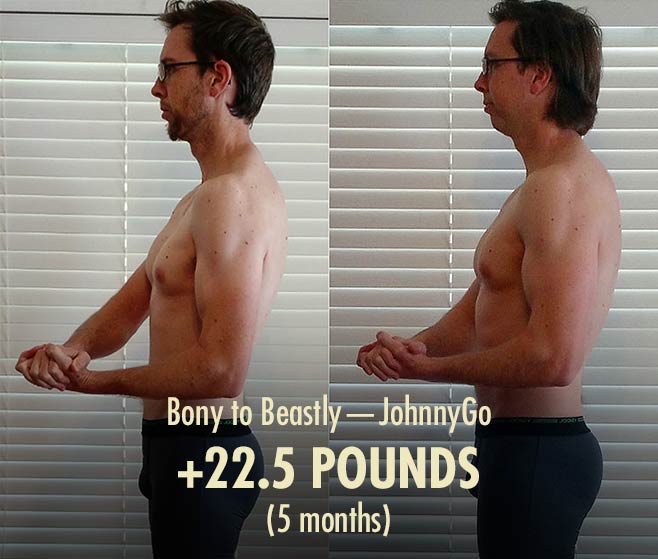
So to build muscle at a good pace while still minimizing fat gain, here’s what we recommend:
- To maximize your rate of muscle growth, you might want to gain as much as a pound per week, which is a calorie surplus of roughly 500 calories per day. This is what we recommend for guys who are eager to become bigger and stronger.
- The minimize your rate of fat gain, you might want to gain muscle as slowly as 0.5 pounds per week, which is a calorie surplus of around 250 calories per day. This is what we recommend for guys trying to a bonafide lean bulk.
So that gives us a rate of 0.5–1 pound per week, or adding 250–500 extra calories into your diet. From there, you can weigh yourself every week and adjust your calorie intake accordingly. Gaining weight too slowly? Add an extra 200 calories. Gaining weight too fast, remove 200 calories. Just keep adjusting as you go along. (Keep in mind that the first week is a bit of a wildcard, given that your stomach will have a bunch of extra food in it. It’s normal to gain 1–3 pounds during your first couple weeks. Wait until week 3 before adjusting anything.)
This means that if you’ve been gaining 2 pounds per week for the past month, we’ve discovered why you’ve gained so much fat. It’s simply because you were eating too much food, and those extra calories were spilling over into fat gain. This is how most people get fat while bulking. They’re overly optimistic about how fast they can gain muscle, they crank their calorie intake too high, and they wind up gaining extra fat.
But even if you’ve been gaining a pound per week, if you’ve been gaining a noticeable amount of fat, you might want to slow it down to 0.5 pounds per week. That’s still enough to gain 20 pounds in a year. It’s still a fast rate of weight gain. But it’s slow enough that any fat gain should be minimal. You may still gain a little bit of fat, but that’s okay, and it should be disguised by your growing muscles.
Summary
The reason people get fat while bulking is because they’re eating too many extra calories, and those extra calories are being stored as body fat. The best way to improve your results is to maximize your rate of muscle growth by improving your workout routine, diet, and lifestyle. That way more of your surplus calories will be invested into muscle growth, leaving fewer to spill over into fat gain. But even then, you still need to gain weight at a reasonable pace. Some beginners can gain muscle faster, but for most people, gaining 0.5–1 pound per week tends to be ideal.
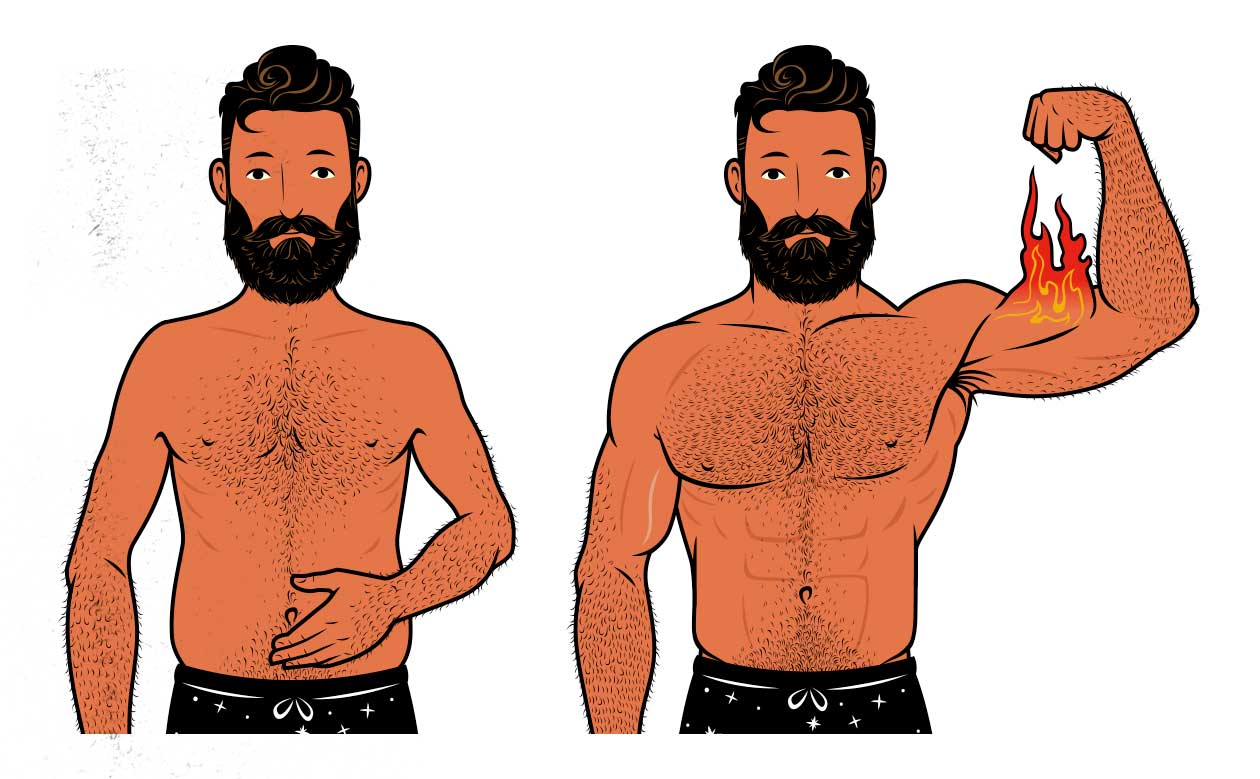
There are a lot of little tips and tricks that you can use to improve your rate of muscle growth, but the fundamentals are:
- Choosing a good hypertrophy workout routine, doing it consistently, and bringing your best effort to each set. Your workouts should be challenging, with your sets brought within a rep or two of muscular failure.
- Eating enough protein, aiming to get at least 0.8 grams of protein per pound bodyweight per day. For a 170-pound guy, that’s at least 136 grams of protein every day. And try to spread that protein out between your meals and snacks, with at least 20 grams every time you eat.
- Getting enough good sleep, setting aside at least 8 hours in bed each night, at least until you get into the habit of waking up before your alarm clock. And try to ease into sleep with a relaxing bedtime routine so that you fall asleep faster and sleep more deeply.
- Living a healthy lifestyle, keeping your drinking and stress under control, getting most of your calories from whole foods, getting outside on a daily basis, and engaging in physical activity, such as walking, sports, or cardio.
- And don’t gain weight too fast! If you’re doing the above points correctly and you’re gaining too much fat while bulking, it’s probably because you’re gaining weight too fast. Gaining 0.5–1 pound per week is good for most people. For the leanest bulking results, aim for 0.5 pounds per week.

As always, if you want a customizable workout program (and full guide) that builds these principles in, check out our Outlift Intermediate Bulking Program. We also have our Bony to Beastly (men’s) program and Bony to Bombshell (women’s) program for skinny and skinny-fat beginners. If you liked this article, you’ll love the full programs.




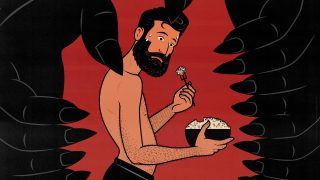
Hi Shane, nice article. Gaining muscle while minimizing fat gain, or, even better, losing fat at the same time is a goal most of us want to achieve.
Bulking, even dirty bulk, and then cutting in next phase is a traditional way since many decades.
However, achieving both is a bit tricky and requires more disciplined approach as you have explained in this article.
Thank you, Farhan! Yeah, trying to bulk leanly definitely makes bulking trickier. And different people have different tolerances for fat gain. The less fat people want to gain, the more finicky the bulk becomes. As a result, I’ve done most of my bulking without trying to keep my gains totally lean. But even then, it still helps to know what factors to be thinking about. That way fat gain never gets confusing or out of hand.
Yes Shane, agreed. Our genetics and physiology have a great role in manipulating that calorie surplus.
Some people gain mostly muscle from bulking with little to no effort, while others gain more fat than muscle despite being very careful.
How does this compare to a person who eats on a calorie surplus but doesn’t do any hypertrophy training? You wrote that overweight people have more fat but also more muscle mass. Just from eating more.
Hey Thomas, yeah, that’s true. If you overeat without doing hypertrophy training, you can expect to gain around 33% lean mass and 67% fat. So if you imagine someone who’s 40 pounds overweight (which is about normal), then they have an extra 13 pounds of lean mass. Lean mass includes extra skin, connective tissue, bone density, and so on. Not all of it is muscle. But a lot of it is.
Thanks for the reply Shane. That’s interesting. My guess is that that 33% will progressively get smaller with the total weight increasing. I mean if a person already 20pounds overweight gets another 20pounds, the increase in lean mass may be even less..
There’s some research that suggests that, yeah. As we become more overweight, we gain an even higher proportion of fat if we continue to gain weight. That’s why you’ll often hear the recommendation to stop bulking once you hit around 20% body fat. At that point, the idea is to trim back to 12–15% so that when you get back to gaining weight, more of it is muscle.
Hi guys! What if I already have a couple extra pounds of fat on me, I’m doing hypertophy training and eating just enough calories to maintain my weight. Won’t my body then use calories from my extra fat to build more muscle? This way I’d lose fat to gain muscle.
I would also like to get a answer for Reimas question.
Hey Reima and Uwe, what you’re talking about is usually called “body recomposition.” It’s a real thing. It often happens. You’ll see it in a lot of studies, especially when the diet isn’t controlled. Most people eat around maintenance, so when you add in hypertrophy training and protein, people tend to gain a bit of muscle and lose a bit of fat.
The average person is an overweight beginner, putting them in an ideal situation for body recomposition. But even then, the rate of muscle growth and fat loss tends to be quite slow–much slower than if you were bulking to build muscle or cutting to lose fat.
The situation changes if you’re skinny or experienced, or if you’re having trouble getting consistent results. In that case, maintaining your weight might simply result in maintenance. Working out and eating a good diet will still be good for your health, but it might not cause any muscle growth or fat loss. This is very common, too.
If you have a few extra pounds, that might not be enough extra pounds. It depends. If you’re at 17% body fat and your body likes being at 17% body fat, you might not see much body recomposition. Think of it like this: 17% is a perfectly healthy body-fat percentage to be at, and there isn’t any extra energy coming in, so your body might not be keen on burning the fat (that it wants to keep) to invest in muscle growth. After all, you’ll need to eat more calories to support more muscle mass, and if you aren’t eating those extra calories yet, your body doesn’t necessarily know if you can find those calories, and so it’s not a wise investment. It might prefer to keep some extra savings around (body fat) in case there are hard times ahead.
So what I’d recommend is starting with body recomposition, seeing how much strength and size you gain, and how much fat you lose. When you stop gaining strength on your lifts, stop getting visibly leaner, or stop gaining any muscle size, switch over to a slow bulk or cut 🙂
For me, even if I do everything correctly, I won’t gain muscle or lose fat in energy balance. I’m already in good shape, so eating at maintenance just maintains the status quo. Different people reach that point at different body compositions. You have to test and see.
I hope that helps!
Thanks for the reply! This is basically what I’ve seen in my own experience. I haven’t gained much muscle at all when eating maintenance calories. I’ll have to see what happens when I increase my calories
Hey Shane, thanks for a great article.
Just a couple questions: I’m in a skinny fat position—(I’m still very light but with noticeable stomach fat)—I want to put on size to look bigger, but I also want to lose my stomach and reduce my bf%. What’s the best route? I’m about 135 pounds at around 18% bf.
18% body fat is still well within the healthy range, so you’d be totally fine to maintain that or even do a slower, leaner bulk. But it’s also not so lean that it would be foolish to lose some fat.
Your first option is to cut. You could do it relatively slowly, trying to gain strength as you go. But if you’re already pretty light and small, you might want to put more emphasis on building muscle first, and it’s harder to build muscle while cutting.
Your second option is to bulk. Again, you could do it relatively slowly, trying to minimize fat gain while doing it. You probably won’t lose any fat or finish looking much leaner, but you should be able to gain quite a lot of muscle strength, putting you in a better position to cut afterwards.
Your third option is to maintain your weight, trying to gain some strength and muscle while losing fat. You could eat according to your appetite, letting your body weight drift up or down a little bit. Whichever way your weight drifts is fine. After all, you aren’t dead set on bulking or cutting right now. You’d just keep lifting, striving for progressive overload, fighting to gain strength. And when you hit a hard plateau, struggling to gain strength on your lifts, then you switch to cutting to lose fat or bulking to build muscle.
That third option is often a good place to start for skinny-fat beginners. But it’s totally up to you and your goals. There’s no best route. I’d just be cautious of cutting, winding up really lean, and then feeling like you need to maintain that leanness. That’s how a lot of guys stay small forever. So if you cut, remember that you’d only want to cut down to something like 13–15%, and then you’d want to shift into a bulk afterwards.
I do think another important factor is your macronutrient split. For example, in a bulk we need to make sure not to eat too much fat. This is because fat is not thermogenic, it is stored easily as no calories are burned while digesting fat. In the context of a caloric surplus, fat is more easily stored as fat. Protein is the most thermogenic followed by carbs. One has to account for the fact that 20-30% of calories from protein are burned just by digesting the food. Hence, having a diet that is too protein-heavy is not good either. The point is some foods consumed during a bulk will keep you in better shape even in a caloric surplus. If your caloric surplus is driven more by higher consumption of carbs (10-15% of calories are burned through thermogenesis) and protein it will produce different results provided adequate muscle is stimulated. An ideal macro split will be 40-50% of calories from carbs, 20-35% from protein, and 15-20% from fats.
Hey Mardig, yeah, that’s a good point. I made a video about the role of dietary fat in fat gain a little while ago.
Your macro recommendations are good. I agree 🙂
I’m a couple months into bulking and am 18% BF, 6′, 189lbs. I can tell I’m gaining too much fat too quickly, got too aggressive lately. Do I need to go below maintenance to correct, or am I ok to just adjust my calories down to ~250 over my TDEE instead of ~500?
Mm. If you want to keep bulking and building muscle, you just need to lower your calorie surplus. 250 is a good surplus for a leaner bulk.
If you want to lose the fat you gained, you’ll need to eat even less. You don’t necessarily need to do that right now, though. I’d finish your bulk and then consider Reverse Bulking or cutting. That way you give yourself time to build a significant amount of muscle.
18% body fat isn’t unhealthy or anything. No need to worry. You caught it plenty early 🙂